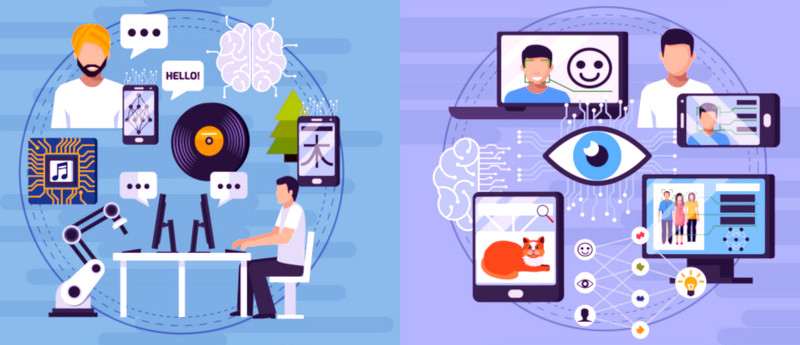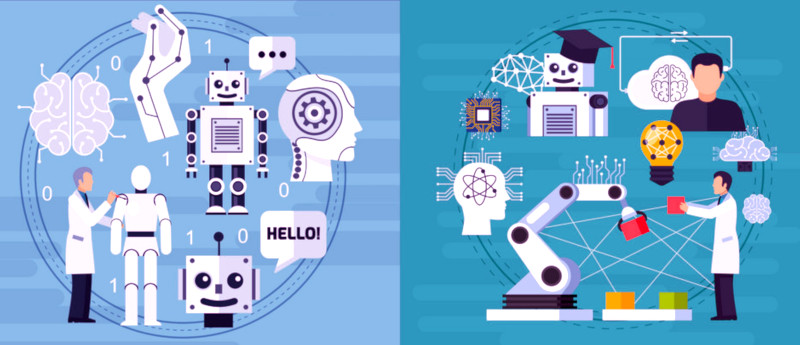Since Artificial Intelligence was created by people and for people, the search for the meaning of this concept should start with us. Intelligence is the thinking ability of humans, so an AI explanation can be derived from a comparison of Artificial Intelligence and Human Intelligence.
Humanity vs. AI (communication)
Artificial Intelligence is a specific field of computer science. This technology is aimed at creating a special kind of machines with intelligence that will be able to behave as humans in particular situations, namely, to recognize human speech and objects, write and read texts and the like. Humans use language to express their thoughts and feelings, to communicate with each other.
AI also has its own method — Natural Language Processing. NLP analyses and generalises speech and voice of human language. A pretty illustrative example of NLP is ‘Google Assistant’. The ability of machine communication is achieved through the use of Speech Recognition. Specialists, who are engaged in the study of NLP technique, call it Statistical Learning, as the whole process is based on statistical methods.
Humanity vs. AI (vision)
Eyes are organs of the human visual system. We use them to see the world around us. Our brain uses this way to obtain a piece of information for better understanding. That is, it turns out that the eyes obey the brain and extract information for it.
Artificial Intelligence uses Computer Vision to perform the same functions. CV helps machines understand and extract necessary information from the surrounding images. Image Processing is a method of understanding and analysing images around by AI.
Humanity vs. Robotics
As is known, living is moving. Humans move in order to live. Moreover, each human activity involves the work of consciousness, as our mind has to guide our movements. Intelligent machines that can move and perform various actions like humans are called robots. Robotics is engaged in their creation as a fairly common direction in AI.
Another AI ability is Pattern Recognition, when robots can categorise a group of objects just like humans do. It is believed that robots classify data much better than humans because they have Pattern Recognition. Automatic learning and improving from past experience refers to the Machine Learning discipline.
Human Brain vs. Neural Networks
Our brain is the centre of the body’s nervous system that controls our mind and contributes to the formation of cognitive capabilities. Thanks to this highly important organ, consisting of neurones, humans learn and receive information, passing it through the analytical centre. We try to recreate similar algorithms and programs based on the structure and functionality of the brain in machines.
Neural Networks are responsible for learning and understanding more complex things and knowledge by implementing Deep Learning. This discipline includes such directions as computer vision and automatic speech recognition. In DL, Convolutional Neural Networks (CNN) are a class of deep Neural Networks that machines use for analysing visual imagery. CNN help artificial intelligence to recognize objects through computer vision. This method is the main result of Deep Learning and other machine learning algorithms. On the other hand, there are also Recurrent Neural Networks (RNN) that are designed as a memorisation mechanism to give machines the ability to remember a number of past events, as humans do.
Human Learning vs. Machine Learning
Scientific research on algorithms and statistical models and their further use for effective performance of a specific task based only on templates and conclusions is considered Machine Learning. In principle, humans are able to accept new information in three dimensions, while machines are not limited in this. Machine Learning goes in many dimensions of data. Machines also can learn how to identify patterns and then, based on it, make predictions and classifications. The human brain is not able to do the same.
Machine Learning Methods
The world knows several ML methods that stem from various types of data and results. One of these methods — which is the primary and most common — is Supervised Learning. The system is given a situation and the required solution, and the ML engineer is involved in the learning process.
Unsupervised Learning is the second method. The system is given a situation only, asked to group the objects by common features and solve the task without any human intervention.
Method 3 is the Reinforcement Learning. The system is given a situation and the ready solution, and tutor is not human but a specific environment.
Another method is Semi-supervised Learning, which is a kind of the interim option between supervised and unsupervised learning. Such a method can be called Method 4, but it is not the last available machine learning technique — it just needs another article.
Interaction
The main question is the compatibility of Humanity and Artificial Intelligence in the near future. It makes everyone think over and over: is it possible at all? Humans created AI to improve life and make things easier thanks to this advanced technology. Furthermore, the Machine Learning types ensure advanced representations and use a complex of various data.
Nevertheless, AI technology is still not so self-sufficient, though very accurate and executive. Human skills and experience still play an important role in the functioning of the AI system. Will Artificial Intelligence ever be able to completely replace humans? This query requires a long analysis and reflection and has no answer yet.


 Telegram
Telegram 
